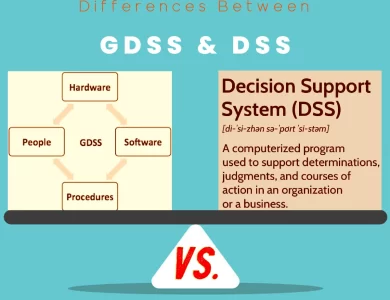Business Intelligence
Discover the Key Differences in Terms and Other Items in Business Intelligence
Welcome to our comprehensive category page dedicated to exploring the fascinating world of Business Intelligence (BI) and uncovering the differences in terms, concepts, and other essential items within this domain. In this information-packed resource, we’ll guide you through various aspects of BI, shedding light on the distinctive features that set different components apart.
Whether you’re a business professional, a data enthusiast, or simply curious about BI, this page is your go-to destination to deepen your understanding of the intricacies within this field. From terminology variations to contrasting methodologies, we’ve got you covered!
-

Decision Support Systems (DSS) vs GDSS Group Decision Support Systems (GDSS)
In the ever-evolving landscape of decision-making tools, two acronyms take center stage: GDSS and DSS. Group Decision Support Systems (GDSS) and Decision Support Systems (DSS) may seem like mere jargon, but they hold distinct roles in shaping strategic choices and operational decisions. GDSS is the orchestra of collaboration, where diverse minds harmonize to tackle complex issues. It's the digital roundtable where participants from various corners of the world collaborate in real-time, molding a decision that embodies collective wisdom. On the other hand, DSS functions as a personal navigator in the sea of data. It assists individuals in making informed choices by providing data-driven insights and analytical tools. Whether it's a financial analyst optimizing investment strategies or a retail manager allocating inventory, DSS is the guiding light in navigating possibilities. GDSS shines when consensus matters. It's the go-to for strategic decisions that impact the entire organization, nurturing an environment where diverse perspectives intertwine. In contrast, DSS thrives in the realm of tactical and operational choices. It empowers users to analyze data, model scenarios, and visualize outcomes, all of which drive precision in decision-making. As you journey through the realms of GDSS and DSS, you'll uncover the intricacies that set them apart – from collaborative symphonies to personalized navigation, from group dynamics to individual empowerment. Embracing these differences illuminates the path to effective decision-making, whether you're orchestrating a strategic shift or charting a tactical course.
-

OLAP vs Data Mining
In the realm of data analysis, Data Mining and Online Analytical Processing (OLAP) are two prominent contenders, each with distinct characteristics. Data Mining involves delving into unstructured data to uncover hidden patterns, making it ideal for groundbreaking discoveries. On the other hand, OLAP facilitates interactive exploration of structured data cubes, offering quick insights for informed decisions. Data scientists often leverage Data Mining's complex algorithms to reveal intricate insights, while OLAP empowers business users with its user-friendly interface for rapid analysis. The choice between Data Mining and OLAP depends on your goals: for discovering the unknown, go for Data Mining; for real-time insights and business intelligence, OLAP is the way to go. Combining both approaches can lead to a comprehensive data strategy that maximizes the value of your data and guides your organization toward success.
-

Data Warehousing vs Data mining
In the realm of data-driven decision-making, two pivotal concepts, data mining and data warehousing, stand as pillars of insight extraction. Data mining involves the art of uncovering hidden patterns, correlations, and trends within extensive datasets. This process is akin to a detective's journey, where algorithms are the magnifying glass, revealing valuable insights that guide predictions and strategic choices. In contrast, data warehousing operates as a secure repository, meticulously collecting and organizing data from diverse sources into a unified hub. Think of it as a structured library, accessible and optimized for efficient querying and reporting. The differences between these powerhouses extend to their purposes, data accumulation methods, structural organization, and user interaction. Data mining thrives on exploration, unearthing unanticipated insights that spark innovation. It's a world of algorithmic exploration, often dealing with complex relationships and real-time streams. On the other hand, data warehousing focuses on historical data, transforming and integrating it into a structured format for reliable decision-making. Structured queries and aggregated insights are the heart of data warehousing, empowering businesses to make informed operational choices. Ultimately, the choice between data mining and data warehousing depends on your organization's goals. While data mining excels at unearthing the unexpected, data warehousing lays the groundwork for structured analysis. A harmonious blend of both approaches, however, can lead to a comprehensive data strategy that unearths insights while providing a reliable foundation for decisions that shape the future.
-

DSS vs EIS vs MIS
In the realm of information systems, MIS, DSS, and EIS stand as three pillars with distinct roles in guiding organizational decisions. Management Information Systems (MIS) focus on streamlining operations and delivering structured data for routine decisions. Decision Support Systems (DSS) step in to empower professionals with insights into complex choices, employing advanced analytics tools and data exploration capabilities. On the other hand, Executive Information Systems (EIS) cater exclusively to top-tier executives, offering aggregated data through intuitive dashboards to facilitate high-level strategic planning. The differences between these systems are multifaceted. MIS aids middle managers and operational staff by providing timely reports and operational insights. DSS bridges the gap between structured and unstructured data, enabling scenario analysis and in-depth decision evaluation. EIS, reserved for top executives, delivers summarized insights for pivotal strategic choices. While MIS focuses on operational efficiency, DSS fosters decision innovation, and EIS guides long-term organizational direction. The interplay of MIS, DSS, and EIS in an organization's decision ecosystem is crucial. These systems harmonize to provide comprehensive support across different decision-making tiers, ranging from the operational to the strategic. As organizations navigate the dynamic landscape of business, understanding the unique contributions of MIS, DSS, and EIS becomes paramount in optimizing decision processes and propelling success.




